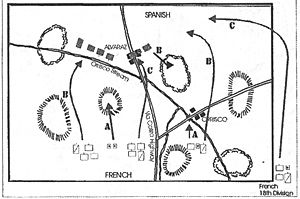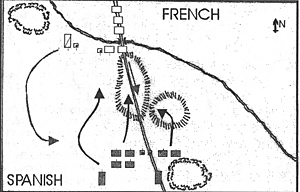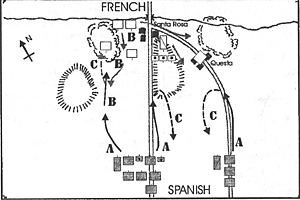Having smashed the combined Spanish armies of the Left and Center at Tres Puentes, the French Ist Corps goes into winter quarters to await reinforcements and to secure its lines of communication. Only minor actions are undertaken as a division is detached to seize the city of Bilbao and subdue the Province of Biscay. In January the French IIlrd Corps crosses the Ebro and establishes a loose blockade of the Spanish Garrison in the city of Saragosa. With the Spanish armies unable to relieve the siege the garrison of Saragosa surrenders on March 3, 1809. In the center of Spain the British army is advancing cautiously and occupies a position south of Madrid near the city of Toledo. Much of the British/Portugese strength is spread out as garrisons or as line of communications troops.
Late in February, taking advantage of a break in the weather and anticipating the onset of spring, the French forces on the eastern coast of the Spanish peninsula, led by the XIIth Corps, push south into the Province of Valencia. The sudden return of bad weather and difficult terrain delay the operation and cause the advancing column to become spread, out offering the Spanish Army of the Right an opportunity to attack, resulting in the Battle of Alvarez on March 5, 1809.
 Battle of Alvarez, March 5, 1089
Battle of Alvarez, March 5, 1089
General Blanco, commanding the Spanish Army of the Right, receives word that the French XIIth Corps has detached several divisions to move against Valencia and decides to attack the French while they are weakened. General Charpentier, commanding the XIIth Corps, learns of the Spanish advance and recalls the 18th Division. Realizing that the French army is much larger than he expected General Blanco attempts to withdraw but his rearguard is overwhelmed and he is forced to halt his withdrawal and assume a defensive position or be overrun on the march. The Spanish army, with 11,500 men and 8 guns, takes position on level ground behind the Orrisco Stream with its left flank anchored in the town of Avaraz. General Charpentier's XIIth Corps, 18,500 men and 24 guns, moves to attack while the 18a' Division, 5,000 men and 8 guns, maneuvers around the Spanish left flank. Due to the pursuit and the need to concentrate forces the battle does not begin until 3:00 PM and can be divided into three short phases.
(A) General Charpentier's right flank, one infantry and one cavalry brigade with a supporting artillery battery, moves to seize the town of Orrisco while the center and left flank advance to threaten the Spanish forces. Two batteries of French artillery move to take up position on the hill dominating the center of the battlefield. The Spanish, heavily outnumbered, await further developments.
(B) The French now move to threaten the Spanish flanks in preparation for their main attack. A French light cavalry brigade swings wide on the right while the French left flank, including two brigades of the Old Guard, moves forward against the Spanish forces behind Orrisco Stream. The Spanish respond by moving the exposed infantry brigade on the left flank into the woods north of Alvaraz, holding their forces behind the stream in position.
(C) At 5:00 PM, with nightfall just an hour away, the French begin their main attack. While the 18th Division begins to deploy on the Spanish left the French center, three brigades of line infantry in column, storm across the stream and drive the Spanish brigade and battery holding Alvaraz from the town in disorder.
The victorious French follow up their success by crashing into the flank of the Spanish infantry lining Orrisco Stream. In a matter of minutes the Spanish flank is rolled up and the outnumbered Spanish are driven from the field. The Spanish lose almost 4,000 men and all their guns while the French suffer just 400 casualties. Including the losses suffered in the earlier rearguard action the Spanish Army of the Right has lost fifty percent of its effective strength and is driven into the mountains to the southwest.
Battle of Alvarez OOB
Spanish Army of the Left (30 AP), 1 General (Inferior), 1 Lieutenant, 5 Brigades Conscript Infantry, 1 Brigade Conscript Cavalry, I Battery Foot Artillery
French XVIIth Corps (53 AP), I General (Superior), 3 Lieutenants, 2 Brigades Elite Infantry, 1 Brigade Light Infantry, 4 Brigades Line Infantry, 1 Brigade Heavy Cavalry, 2 Brigades Light Cavalry, 1 Battery Horse Artillery, 2 Batteries Foot Artillery - French 18th Division (14 AP), 1 Lieutenant, 2 Brigades Line Infantry, 1 Brigade Light Cavalry, 1 Battery Foot Artillery
Campaign Moves, March 8-14, 1809
After the defeats suffered at the start of the campaign the Spanish Army of the Center absorbs the remnants of the Army of the Left and a new Army of the Left is created out of troops gathered over the winter at Burgos. Undaunted by their setbacks the Spanish immediately move to attack the French Ist Corps south of the Ebro. Their plan is to pin the French using the Army of the Left while the Army of the Center envelops the French left flank. Poor communications delay the start of the Army of the Center leaving the raw Army of the Left to face the French alone. To make the Spanish situation worse the French IInd Corps has moved south of the Ebro and is available to reinforce the Ist Corps.
 Battle of Estancia, March 14,1809
Battle of Estancia, March 14,1809
The Spanish Army of the Left, deploying 14,500 men and 16 guns commanded by General Espana, has taken up a weak position north of the town of Estancia. Although a forest is available to secure the right flank two hills to the front provide dominant terrain and will serve to screen French movements. French General Ardant's plan is straightforward and simple. With almost 12,000 men and 24 guns available he will send his infantry straight up the road over the hills to smash through the Spanish while a brigade of cavalry moves to outflank their line. As the battle open at 8:00 AM General Espana receives a dispatch indicating that the Spanish Army of the Center will not be arriving and that he is on his own. Realizing that the French will be able to dominate his position from the hills he launches his infantry forward to attack the French as they deploy, sending one of his cavalry brigades in a short hook, inside the arc of the French flanking cavalry, to threaten the French right flank. The unexpected attack causes some confusion in the French ranks and the Spanish are able to drive the lead brigade back and then out of the battle. Unfortunately for the Spanish commander, his cavalry refuses to charge and is caught in the flank and smashed by the French cavalry brigade. Further Spanish attacks on the hill are less successful and as the French forces get themselves sorted out the tide of battle turns in their favor. As the French attack all along the line and casualties mount, Spanish units begin to stream for the rear. General Espana orders a withdrawal and the valiant stand of one or two brigades allows the Spanish army to retreat is good order. By 10:30 AM the battle is over with the Spanish suffering 3,800 casualties and withdrawing into the mountains to the south. French loses were fairly heavy in this short but hard-fought battle, suffering over 1,700 killed and captured. The Spanish army is defeated before the French IInd Corps can arrive.
Battle of Estancia OOB
Spanish Army of the Left (30 AP), 1 General (Average), I Lieutenant, 6 Brigades Conscript Infantry, 2 Brigades Conscript Cavalry, 2 Batteries Foot Artillery
French Ist Corps (34 AP), 1 General (Average), 2 Lieutenants, 2 Brigades Light Infantry, 3 Brigades Line Infantry, 1 Brigade Light Cavalry, 3 Batteries Foot Artillery.
Campaign Moves, March 15 - 28, 1809
For the French, the campaign appears to be going well. Spanish forces have been defeated several times and several Spanish provinces subdued. General Ardant's forces in northern Spain are moving to threaten Madrid while General Rohan's forces in south-eastern Spain continued to move down the coast, taking Valencia and dispersing a Corps of recently gathered Spanish volunteers outside Murcia. The British field army, which had moved to a position south of Madrid, now shifts to the east to threaten the line of communications of the French IXth Corps at Murcia. Additional British forces have been landed in Portugal but are slow in moving to the front and a substantial number are being diverted for drive into the northern part of Spain.
The Spanish Army of the Right, having moved briefly to attempt the relief of the Saragosa garrison, withdraws through the mountains to defend Madrid. General Espana's Army of the Left, leaving a strong garrison in Burgos, moves to threaten the French IInd Corps, still south of the Ebro River and covering the communications of the Ist Corps now approaching Madrid. The Spanish Army of the Center is broken up to provide reinforcements for the Army of the Left and garrisons for key positions.
 Battle of Questa, March 23, 1809
Battle of Questa, March 23, 1809
The French IInd Corps, 12,000 men and 24 guns under the command of General Morand, takes up a strong defensive position south of the Santa Rosa River. Morand's left flank is defended by a brigade deployed in the town of Questa while his center consists of a grand battery of 24 guns backed up by a light cavalry brigade. His right flank, a brigade of light infantry and one of line infantry are anchored in the forest west of the town of Santa Rosa. Two brigades of infantry remain in reserve. General Espana's Army of the Left, 21,000 men with 16 guns, is deployed along the two main roads in the area, one leading straight into Santa Rosa and the other through Quests. The right flank force, consisting of three infantry and one cavalry brigade is intended to threaten Questa and the flank of the French forces on the central hill. The balance of the Spanish force, six infantry brigades, one cavalry brigade, and two batteries, will advance up the Santa Rosa Road.
(A) From the start the Spanish attack suffered difficulties. The movement of the right flank was tardy while the left flank moved quickly forward and discovered the French grand battery. The leading Spanish infantry brigade broke under the French battery's intense fire and started a panic that weakened the morale of the Spanish left. Although Spanish counter-battery fire was successful in inflicting some losses on the grand battery it continued to hammer the advancing Spanish force. The Spanish right flank cavalry brigade now moved against the hill in an attempt to silence or distract the grand battery but are met and defeated by the French light cavalry brigade.
(B) As this was taking place the French also advanced their two right flank infantry brigades and deployed their two reserve brigades, one into the center and the other to back up the battery and the brigade in the town of Questa. At this point the Spanish scored their only successes of the battle. A charge by a French infantry brigade on the Spanish left is halted and then driven back by a Spanish countercharge. The French grand battery also is silenced and forced to withdraw to reorganize. Unfortunately, it is too little too late.
(C) While the Spanish on the far left are able to advance, the Spanish center and right flank are in bad shape having already suffered heavy casualties from the Grand Battery. Desperate attacks on the hill and the town of Quests are thrown back with heavy loss and with cries of "treason" filling the air another Spanish army quits the field. Losses are heavy for the Spanish with over 6,000 men killed or captured during the battle and the relentless French pursuit. French losses, again, are amazingly light, with just 300 killed. The Spanish Army of the Left is driven back on its depots around Burgos
Battle of Questa
Spanish Army of the Left (39 AP), 1 General (Average), 2 Lieutenants, 9 Brigades Conscript Infantry, 2 Brigades Conscript Cavalry, 2 Batteries Foot Artillery
French IInd Corps (35 AP), 1 General (Superior), 2 Lieutenants, 1 Brigade Elite Infantry, 1 Brigade Light Infantry, 3 Brigades Line Infantry, 1 Brigade Light Cavalry, 3 Batteries Foot Artillery.
A Peninsula War Campaign Nov 1808-Jun 1809 Fought Using Le Petit Armee Rules and Campaign Rules
- Introduction
Campaign Moves (Nov-Dec 1808)
Campaign Moves (Dec 1808 - March 1809)
Campaign Moves (April - June 1809)
Back to MWAN # 124 Table of Contents
Back to MWAN List of Issues
Back to MagWeb Magazine List
© Copyright 2003 Hal Thinglum
This article appears in MagWeb.com (Magazine Web) on the Internet World Wide Web.
Other articles from military history and related magazines are available at http://www.magweb.com